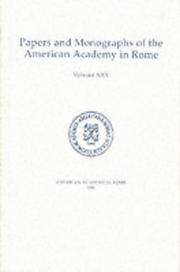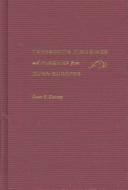| Listing 1 - 8 of 8 |
Sort by
|
Book
ISBN: 069103589X Year: 1988 Publisher: Princeton (N.J.): Princeton university press
Abstract | Keywords | Export | Availability | Bookmark
 Loading...
Loading...Choose an application
- Reference Manager
- EndNote
- RefWorks (Direct export to RefWorks)
Architecture --- -Architecture, Western (Western countries) --- Building design --- Buildings --- Construction --- Western architecture (Western countries) --- Art --- Building --- Design and construction --- Middle East --- Asia, South West --- Asia, Southwest --- Asia, Western --- East (Middle East) --- Eastern Mediterranean --- Fertile Crescent --- Levant --- Mediterranean Region, Eastern --- Mideast --- Near East --- Northern Tier (Middle East) --- South West Asia --- Southwest Asia --- Orient --- Antiquities. --- Civilization --- -Religion. --- -Middle East --- Religion.

ISBN: 047210571X 9780472105717 Year: 1998 Volume: 30 Publisher: Michigan University press
Abstract | Keywords | Export | Availability | Bookmark
 Loading...
Loading...Choose an application
- Reference Manager
- EndNote
- RefWorks (Direct export to RefWorks)
--Forum Boarium --- --Regia --- --Fouilles --- --6608 --- Regia (Rome, Italy) --- Excavations (Archaeology) --- Terra-cotta sculpture, Roman --- Roman terra-cotta sculpture --- Terra-cotta sculpture, Classical --- Archaeological digs --- Archaeological excavations --- Digs (Archaeology) --- Excavation sites (Archaeology) --- Ruins --- Sites, Excavation (Archaeology) --- Archaeology --- Roman Forum (Rome, Italy) --- Rome (Italy) --- Foro Romano (Rome, Italy) --- Forum Romanum (Rome, Italy) --- Rome (Italy : Commune) --- Rome (Italy : Governatorato) --- Rūmah (Italy) --- Roma (Italy) --- Rom (Italy) --- Rím (Italy) --- Rzym (Italy) --- Comune di Roma (Italy) --- Rome --- Antiquities, Roman. --- Architecture romaine --- Archéologie --- --Rome --- --Archéologie --- --Regia (Rome, Italy) --- Rome (Italy : Comune) --- Terra-cotta sculpture, Roman - Italy - Rome --- Excavations (Archaeology) - Italy - Rome --- Fouilles --- Forum Boarium --- Regia --- Rome (Italy) - Antiquities, Roman.
Book
Year: 1969 Publisher: New Haven (Conn.) : Dura-Europos publications,
Abstract | Keywords | Export | Availability | Bookmark
 Loading...
Loading...Choose an application
- Reference Manager
- EndNote
- RefWorks (Direct export to RefWorks)

ISBN: 0472112376 Year: 2003 Publisher: Ann Arbor (Mich.) : University of Michigan press,
Abstract | Keywords | Export | Availability | Bookmark
 Loading...
Loading...Choose an application
- Reference Manager
- EndNote
- RefWorks (Direct export to RefWorks)
Located above the Euphrates in modern Syria, Dura-Europus was founded as a Hellenistic military settlement. It was conquered repeatedly by Parthians, Romans, and Persians but evidence from inscriptions, graffiti, and papyri suggests that, throughout all this upheaval, the Greco-Macedonian aristocracy maintained its sway over the city's society. Susan B. Downey demonstrates how the terracotta figurines and plaques from Dura-Europus, relatively humble products, can shed light on religious beliefs and social practices in cities of mixed Greek and Semitic population. These artifacts reveal the stories of the city's people. Dura is exceptionally well preserved, due to the dry climate and to the fact that it was not re-inhabited after it fell to the Sasanian Persians in approximately C.E. 256. Approximately 300 figurines and plaques were discovered in the excavations of Dura, yet few have been published. Properly determining the uses of artifacts like these is difficult. The terracottas might have functioned in a religious context, as talismans, or as toys--to name only a few possibilities. This exhaustive collection meticulously catalogues the Dura finds, offering the first complete listing of the terracottas and plaques. Combined with Downey's insightful analyses, the catalogue represents a monumental contribution to our knowledge of the lives and activities of the inhabitants of this important antique center of multiculturalism. This book will prove an invaluable resource for anyone interested in the social history and religious life of Dura-Europus. Archaeologists, art historians, and general classicists alike will find it valuable. Susan B. Downey is Professor of Art History, University of California, Los Angeles.
Plaques, plaquettes --- Terra-cotta figurines, Ancient --- Dura-Europos (Extinct city). --- Syria --- Antiquities
Book
ISBN: 0917956044 Year: 1977 Volume: 5 Publisher: Los Angeles : Institute of Archaeology, University of California,
Abstract | Keywords | Export | Availability | Bookmark
 Loading...
Loading...Choose an application
- Reference Manager
- EndNote
- RefWorks (Direct export to RefWorks)

ISBN: 9780472112371 Year: 2003 Publisher: Ann Arbor : Michigan University Press,
Abstract | Keywords | Export | Availability | Bookmark
 Loading...
Loading...Choose an application
- Reference Manager
- EndNote
- RefWorks (Direct export to RefWorks)
Excavations (Archaeology) --- Plaques, plaquettes --- Terra-cotta figurines --- Fouilles (Archéologie) --- Plaques (Arts décoratifs) --- Figurines de terre cuite --- Dura-Europos (Extinct city) --- Syria --- Doura-Europos (Ville ancienne) --- Syrie --- Antiquities --- Antiquités
Book
Year: 1969 Publisher: New Haven Dura-Europos
Abstract | Keywords | Export | Availability | Bookmark
 Loading...
Loading...Choose an application
- Reference Manager
- EndNote
- RefWorks (Direct export to RefWorks)
Book
ISBN: 9781938770067 Year: 2016 Publisher: Los Angeles : The Cotsen Institute of Archaeology Press,
Abstract | Keywords | Export | Availability | Bookmark
 Loading...
Loading...Choose an application
- Reference Manager
- EndNote
- RefWorks (Direct export to RefWorks)
"This festschrift honors UCLA professor emerita Susan Downey and her meticulous scholarship on religious architecture and imagery in the Roman/Hellenistic world. The iconography of gods and goddesses, the analysis of sacred imagery in the context of ancient cult practices, and the design and decoration of sacred spaces are the main themes of the book. Authors examine such subjects as painting from Dura-Europos, Hellenistic sculpture at Saqqara in Egypt, Roman cameo glass, Pompeian fresco, and aspects of Venus in portrait sculpture. The essays on Dura-Europos are especially valuable in light of the present turmoil in the region.Professor Downey's influence shines through in these discussions, which echo her mentorship of several generations of art history and archaeology students and recognize her scholarly achievements. The broad temporal and geographic parameters of the volume are expansive, and the juxtaposition of images and analyses leads to surprising new conclusions"-- "This festschrift honors UCLA Professor Emerita Susan Downey's meticulous scholarship on the Classical World architecture of sacred spaces, and the objects and imagery contained in those spaces. The contributors, former students and current colleagues of Susan Downey, demonstrate a shared concern for very careful consideration of the evidence in their analyses of religious iconography, cult practices and sacred edifices. The book is divided into sections that echo the title of the volume: icon, cult, and context. The iconography of gods and goddesses, analysis of sacred imagery in the context of ancient cult practices, and the design and decoration of sacred spaces are the main themes of the book. Professor Downey's influence shines through in these discussions of cult objects, iconography, and religious architecture, which echo her mentorship of several generations of art history and archaeology students, and recognize her scholarly achievements"--
Sacred space --- Religious articles --- Art and religion --- Cults --- Lieux sacrés --- Objets d'art religieux --- Art et religion --- Cultes
| Listing 1 - 8 of 8 |
Sort by
|

 Search
Search Feedback
Feedback About UniCat
About UniCat  Help
Help News
News